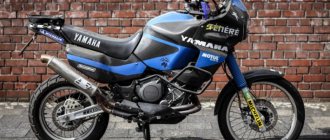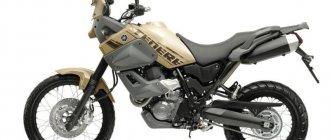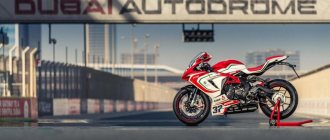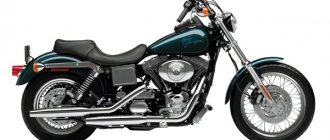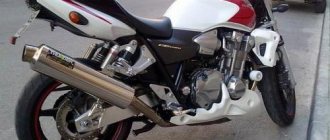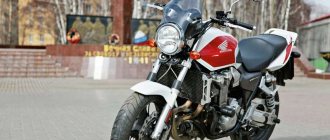000_MOTO_1110_026
Yamaha XT1200Z Super Tenere: touring enduro, 2010, 1199 cm³, 110 hp, 261 kg, 650,000 - 680,000 rub.
Yamaha XT1200Z Super Tenere: touring enduro, 2010, 1199 cm³, 110 hp, 261 kg, 650,000 - 680,000 rub.
Immediately after the appearance of official photographs of the new Super Tenere, two “shadows” appeared behind its “back”. One is from the past, the other is from the present, which, in principle, is natural. The name of the new product speaks of its relationship with its predecessor from 1989, and the external data and performance characteristics indicate its relationship with the main opponent of the present one, the famous “Bavarian”. Another thing is surprising: some wanted to see in the new XT1200Z the reincarnation of the old “Peterhansel fighting machine,” “but only better,” while others were looking forward to “Pimp” putting “Goose” in his belt. It was even a little sad to see how disappointed both of them were. What exactly is the brand new Super Tenere?
In reality, Super Tenere looks a little more massive than in the photographs. But this cannot be considered a disadvantage. At first glance, it is clear that this is a full-fledged touring enduro without any hint of versatility. You don’t even have to go anywhere to understand this. “Pimp” is a classic long-range all-terrain vehicle. This is not an “Italian”, which seems to be both in feast and in peace, but in reality it is a slightly “pushed up” sportbike. I didn’t make a reservation - this device, like, in general, all its other classmates, in off-road conditions will feel little better than another sports tourer or a classic: the mass makes itself felt, no matter what toothy tires you install, no matter how you increase the ground clearance, and pulling a three hundred kilo carcass out of a muddy rut is an unpleasant and often futile task.
Despite its enduronic nature, the layout of the device raises questions. Firstly, the oil filter is strangely located, sticking out in front of the engine as a “primary sexual characteristic”. On my copy from the first edition series, a high-quality aluminum crankcase protection is already installed at the factory, protecting the filter from adversity, but starting next year this part, important for enduro, will become an option. And not cheap at all. Secondly, the location of the cooling system radiators. The side-by-side layout undoubtedly made it possible to move the engine forward and improve the weight distribution of the device, but any, even the most harmless fall threatens to result in an antifreeze leak, and you won’t go far without it. This scheme is justified, for example, on a Honda VFR, but the “vyfer” by default is always within reach of a tow truck, because it was born to drive on asphalt, but what if you use the “Suter” in the African savannah or on the Caucasus mountain trail? In general, protective bars are strongly requested here. I think many people will not really like the need to modify the device with a file and a wallet. Although, knowing current customs, I’m almost sure that most of the Suters sold will never go further than a hundred meters from the asphalt, and the device still needs to be modified for serious hikes. So, it turns out that Yamaha has released another SUV? Or did she reduce the cost of the device due to options that are unnecessary for most?
Review of the Yamaha XTZ 750 Super Tenere motorcycle
On my first trip I probably covered 350 kilometers. I was amazed at how he eats any asphalt and soil. At first, with a “road” look, I simply made five-ruble eyes in front of the big asphalt holes, but then I realized that they didn’t mean anything to him at all. The road workers drive, slow down to 50-60 km/h, maneuver between potholes, and I was driving at 90-100 km/h.
And then the first trip to the sand! I learned a lot of new things about myself then. Especially how I can comment on the events happening to me and combine them with Russian folklore, codenamed “MAT”. In short it was a kick-ass! I realized that it was still too early for me to go to the sand. I still need to get used to the motorcycle.
I won’t write about how I traded the XTZ for a KLR, this is probably not particularly necessary information.
I’d rather write this... XTZ750 is a great motorcycle!
Provided that you understand what you want from him. To burn on it, you need to have the skill and practice. Considering that I used this motorcycle in a very unusual way (exclusively off-road), it was not easy for me to ride it. I just used it as an enduro. I have been in different conditions: sand, liquid sand, mud, a river, puddles, fields with grass and mud, galloping across a field dug up by a tractor and then dried up... No, I didn’t do it on purpose. There were just different kinds of conditions along the way. I went everywhere, and you can drive it everywhere, it can. Provided that YOU can handle it. No, I’m not an athlete at any given time, and I don’t have any enduro experience, but it’s possible. With every ride I discovered something new about the motorcycle. I was amazed by its capabilities! Yes, after every endurope ride I was in a state of shock, but I understood that this motorcycle could do much more than I could! Because he goes almost everywhere! What to write about the motorcycle itself? So, a lot has been written about it: it’s good at long-range driving, it has excellent traction, good suspension for Russia, it’s relatively simple and not expensive to maintain, and the spark plugs can be changed without even removing the plastic. Yes, in principle it is not difficult to maintain.
Considering that now there is a unification (motorcycles are becoming the same type and characterless) of motorcycling (they even put checkers with ABS), then the SuTer can be said to be a very hardcore motorcycle. It has a spirited engine, it loves to rev, it has grippy brakes and is generally a distinctive car, essentially, so I would say to a newbie, “Think carefully, do you need it?”, but I wouldn’t dissuade him. Because I don’t regret the time I spent with him one bit.
It has a spirited engine, it loves to rev, it has grippy brakes and is generally a distinctive car, essentially, so I would say to a newbie, “Think carefully, do you need it?”, but I wouldn’t dissuade him. Because I don’t regret the time I spent with him one bit.
A weak rear subframe can burst under severe loading or when driving on crappy roads like we all love here. It is recommended to strengthen in advance.
A parallel twin from a Yamaha (especially one that is not new, or one that has been broken in incorrectly) likes to snack on oil. Especially at high speeds (which you usually keep on the highway). On hauls of 1000 kilometers per day, I recommend that you initially monitor the level twice a day.
For my taste, the 520th chain is a bit weak for such a heavy car, but this is one of the whims. If I remember anything else, I’ll write. In general, I consider the XTZ750 one of the best tourenduros ever produced (in terms of price/quality ratio, of course)
I use Suter for 1 season, mileage is about 30 thousand. The range in single long-distance trips is up to 6 thousand. I'm completely satisfied))
Pros (for me): good dynamics on the highway, excellent steering despite its height and weight, good top speed (up to 200 mph in a long distance, although it eats like an elephant at such speeds), you can move without bothering on any surface, including climbing in not the most severe shit, comfortable high seating position with normal wind protection, especially with a tuned windshield, the ability to load it on a long-distance road trip (don’t forget about the subframe - it burst in 4 places), good range, dry sump, undemanding to the quality of gasoline, requires maintenance but needs to be done it is not difficult..
The fly in the ointment: the device is a bit old - spare parts are expensive and made to order, although consumables are quite affordable;
The subframe needs to be strengthened, the oil needs to be checked, or if there is a lot of heat, get into the engine and then run it in again;
The light is rather weak and you can’t do much better - xenon is of course possible, but depending on the base, there may be problems finding xenon lamps for this base. By the way, with large suspension strokes, this moto will blind anyone - it’s been tested by its brothers. In addition, it is not recommended to simply install more powerful lamps - the generator is rather weak. Complete with heated grips, foglights and night driving, it’s easy to fit the battery. And I also power my mobile phone from the cigarette lighter and sometimes I connect the pump..
The 520th chain, in principle, runs normally if you don’t tear the handle. And he was a hooligan here at one time - Suter was training to lift the rear and organize drag racing with people))) With a bang, the chain-sprocket set went to waste.. There is an option for installing analogues under the 530 - you have to dig around, there is data, but you can’t get your hands on it They'll come look and change it.
There is also a problem - there are no standard arches for it, according to Louis - they are frankly weak, they are not recommended for installation, you just have to do it yourself, and that is the problem of the places where the arches are attached. However, this can be solved. Look at the motor in the special window for these devices.
PS: despite all the disadvantages of this device, having driven Transalpe650, Africa and Suter, I chose Suter. I'm happy and don't plan to change it, it's a cool device).
008_MOTO_1110_026
The military-style tidy looks brutal.
But not at the expense of information content. The military-style tidy looks brutal. But not at the expense of information content.
In motion, the motorcycle turned out to be much “smaller” than it looked: 261 kilos are not felt at all. The device is a little difficult to corner at all speeds above walking speed; understeer here is inherent in the design - this way the bike is less susceptible to wobbles on rocks, ruts and other irregularities. This means that there is still potential for off-road driving. The work of the pendants also reinforces this idea. Even though there are no newfangled electrical adjustments for hydraulics and springs, the fork and rear monoshock absorber cope with the tricky conditions of asphalt, country roads and graders really well. Motik does not prowl, does not jump on grader waves and even easily digests jumps from low springboards. Despite all the “off-road” suspension settings, the motorcycle behaves on asphalt no worse than any other classic. Longitudinal swings during acceleration and braking are minimal.
The engine also performed excellently. 1199 “cc” confidently pull the car from the lowest speeds, although it is felt that for the sake of juicy traction at the “bottoms” and in the “middle”, the Yamaha team openly sacrificed the “tops”. Perhaps even too much. Although this option is not for everyone. For example, I generally prefer “low-level” engines, be it a car diesel engine or a chopper “top”, so it’s to my taste. The only “but” is the adjustment of the “electronic” throttle grip. The brains that control the throttle valves are a little, literally a split second, behind the pilot’s commands. It seems not much, but in some situations these tenths are not enough. For example, instead of moving quickly, the motorcycle simply stalls. Your hands automatically operate the gas and clutch, but here you need to apply the gas a little earlier, or start releasing the clutch a little later. It’s a matter of habit, of course, but somehow it doesn’t suit a serious person. Well, perhaps the last nuance of the XT1200Z engine is the sound of operation. Almost everyone who heard the Suter working for the first time asked if everything was okay with it. It's okay, guys! It's Yamaha! The engine is very talkative. Naturally, we are not talking about the exhaust, but rather about the polyphony of rattling hardware in the engine itself. Maybe some people won’t like this, but I was extremely pleased when I opened the gas and heard literally every piece of hardware in the engine. A real “combat” racing projectile. Have you ever heard how the engine of, for example, a rally car works?
There are no complaints about ABS: the system works predictably and smoothly. But the YCC-T stabilization system was a little disappointing. Instead of smoothly keeping a skid or slide within safe limits, allowing the pilot to enjoy the “wagging of the tail” during acceleration and turns with a skid, it smothers all “undesirable” tendencies in the bud, and very harshly. The difference between the “road” and “off-road” modes is only that if in the first YCC-T suppresses slips, drifts and attempts to tear off the front wheel in the bud, then in the second it turns on with some delay, although it works just as categorically . Competitors' similar systems are more finely tuned. But, unlike most, on the Suter the stabilization system can be turned off, and this is a definite plus. In short, YCC-T provides the necessary level of security, but harms the “drive”.
The purpose of the Yamaha D-Mode system on this motorcycle is not entirely clear. In fact, “the ability to change engine operating modes” comes down to only the ability to choose between two levels of throttle damping. Roughly speaking, if in the first mode the dependence of the opening angle of the throttle valves on the rotation of the knob is linear, then in the second - in order to drive “the same way”, you just need to turn the “knob” harder. Of course, on motorcycles such as, for example, the R1 with a crazy population under the tank and sharp engine reactions, such a system is justified, but here, on a “low-end” engine with excellent feedback on the throttle and “stabilizer”, this option is not more than a "bauble".
Overall ergonomics rating: good. The saddle is very comfortable for both the pilot and the passenger. Although you wouldn’t expect anything else, because at first glance you can see from which “German” its design was borrowed. And for him this part is considered almost an ideal in the class. The wide steering wheel is located exactly where it is needed, close enough to the pilot - you don’t have to reach for it, which means that the Suter will be comfortable not only for lanky people like me, but also for people of average height. But I would like to move the footrests a little forward: the sitting position is fine, but the stand is somehow uncomfortable - you have to lean over too much. Well, perhaps the last “ah-yay-yay” is the windshield adjustment system. Long ago, all “progressive humanity” switched to quick adjustment systems, be it latches or thumbscrews; here, in order to raise or lower the glass (there are only two positions), you need to arm yourself with a screwdriver.
Despite some shortcomings, I liked the motorcycle. Ergonomics, ease of control, comfort, engine and suspension settings, everything is worked out with high quality, and the rest are “baubles” and nuances that have little effect on the ride. The motorcycle is truly capable of being an excellent long-range projectile, both on paved roads and beyond. And the number and cost of potential modifications necessary to bring the device to “full combat readiness” will be small, given the price of the device itself. Super Tenere has turned out to be a really strong competitor to the current giants of the touring enduro class, and very soon it will prove it. In one of the upcoming issues of “Moto” we will pit the best of the best against each other, and I am sure that “Suter” will not give up!
Technical specifications of Yamaha XT1200Z Super Tenere (manufacturer data)
| COMMON DATA | |
| Model year | 2010 |
| Wheelbase, mm | 1540 |
| Curb weight, kg | 261 |
| Length x width x height, mm | 2250×980×1410 |
| Ground clearance, mm | 205 |
| Seat height, mm | 845–870 |
| Gas tank volume, l | 23 |
| ENGINE | |
| Type | R2, 4T |
| timing belt | DOHC, 4 valves per cylinder |
| Working volume, cm3 | 1199 |
| Dimension, mm | 98x79.5 |
| Compression ratio | 11:1 |
| Supply system | fuel injection |
| Cooling system | liquid |
| Starting system | electric starter |
| Max. power, hp at rpm | 110/7250 |
| Max. torque, Nm at rpm | 114,1/6000 |
| TRANSMISSION | |
| Clutch | multi-disc, oil bath |
| Transmission | 6-speed |
| main gear | cardan shaft |
| CHASSIS | |
| Frame | steel, spatial, closed through the power unit |
| Front suspension | inverted telescopic fork, fully adjustable |
| Pipe diameter, mm | 43 |
| Stroke, mm | 190 |
| Rear suspension | pendulum, with progressive characteristics and hydraulic shock absorber with adjustable spring preload and rebound force |
| Stroke, mm | 190 |
| Brake system | Hydraulic semi-combined (braking of both wheels from the steering lever), with ABS and stabilization system |
| Front brake | 2 discs ∅ 310 mm |
| Rear brake | 1 disk ∅ 282 mm |
| Wheels | aluminum spoked |
| Front tire | 110/80R19, tubeless |
| Rear tire | 150/70R17, tubeless |
The motorcycle for testing was provided by Yamaha Motor CIS, Dainese equipment was provided by the Eurosport-Motors salon.
Yamaha XT1200Z Super Tenere test
Glass
Its mechanical adjustment in practice is not entirely convenient.
Here the “smartphone effect” is manifested in all its glory. Suspension units now have expanded functionality, which means you start tinkering with it all the time. It's fun at first, but eventually you realize you're distracted from driving. I sat down the passenger, clicked the buttons on the second helmet on the instrument panel, drove along the highway, released the suspension, and tightened it in the city. Everything works smoothly, but the settings interfaces are not the simplest. Using two rocker buttons, you need to find a specific mode on the LCD panel, then click on the required number of adjustment positions and wait until they “take effect”. Moreover, the preload in all possible combinations is set only statically, and applying the selected position takes about a minute. It’s like on a smartphone: go ahead, I’ll catch up with you as soon as I upload the photo, 3G works well in this place!
